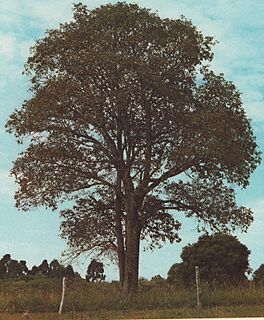
Celtis is a genus of about 60–70 species of deciduous trees, commonly known as hackberries or nettle trees, widespread in warm temperate regions of the Northern Hemisphere, in southern Europe, southern and eastern Asia, and southern and central North America, south to central Africa, and northern and central South America. The genus is present in the fossil record at least since the Miocene of Europe, and Paleocene of North America and eastern Asia.

Trema is a genus of about 15 species of evergreen trees closely related to the hackberries (Celtis), occurring in subtropical and tropical regions of southern Asia, northern Australasia, Africa, South and Central America, and parts of North America. They are generally small trees, reaching 10–20 m (33–66 ft) tall.

Lake Fryxell is a frozen lake 4.5 kilometres (2.8 mi) long, between Canada Glacier and Commonwealth Glaciers at the lower end of Taylor Valley in Victoria Land, Antarctica. It was mapped in the early 1900s and named during Operation Deep Freeze in the 1950s. There are several forms of algae living in the waters and a weather station located at the lake.

Cissus is a genus of approximately 350 species of lianas in the grape family (Vitaceae). They have a cosmopolitan distribution, though the majority are to be found in the tropics.

Cordyline is a genus of about 15 species of woody monocotyledonous flowering plants in family Asparagaceae, subfamily Lomandroideae. The subfamily has previously been treated as a separate family Laxmanniaceae, or Lomandraceae. Other authors have placed the genus in the Agavaceae. Cordyline is native to the western Pacific Ocean region, from New Zealand, eastern Australia, southeastern Asia and Polynesia, with one species found in southeastern South America.

Vismia is a genus of flowering plants in the family Hypericaceae. Members of the genus are small trees and shrubs found in tropical and subtropical areas of Africa, Central America, and South America.

Schefflera is a genus of flowering plants in the family Araliaceae. With an estimated 600–900 species, the genus represents about half of its family. The plants are trees, shrubs or lianas, growing 4–20 metres (13–66 ft) tall, with woody stems, the absence of articulated pedicels and armaments, and palmately compound leaves.

Ulmus wallichianaPlanch., the Himalayan elm, also known as the Kashmir elm and Bhutan elm, is a mountain tree ranging from central Nuristan in Afghanistan, through northern Pakistan and northern India to western Nepal at elevations of 800–3000 m. Although dissimilar in appearance, its common name is occasionally used in error for the cherry bark elm Ulmus villosa, which is also endemic to the Kashmir, but inhabits the valleys, not the mountain slopes. The species is closely related to the wych elm U. glabra.

Ulmus mexicana(Liebm.) Planch., the Mexican elm, is a large tree endemic to Mexico and Central America. It is most commonly found in cloud forest and the higher elevations (800–2200 m) of tropical rain forest with precipitation levels of 2–4 m per year, ranging from San Luis Potosi south to Chiapas in Mexico, and from Guatemala to Panama beyond. The tree was first described botanically in 1873.

Ampelocissus is a genus of Vitaceae having 90 or more species found variously in tropical Africa, Asia, Central America, and Oceania. The type species, A. latifolia, was originally treated under its basionym, Vitis latifolia, and was collected from the Indian subcontinent.

Hydrotalcite is a layered double hydroxide (LDH) of general formula Mg
6Al
2CO
3(OH)
16·4H
2O, whose name is derived from its resemblance with talc and its high water content. The layers of the structure stack in multiple ways, to produce a 3-layer rhombohedral structure, or a 2-layer hexagonal structure formerly known as manasseite. The two polytypes are often intergrown. The carbonate anions that lie between the structural layers are weakly bound, so hydrotalcite has anion exchange capabilities.
The APG III system of flowering plant classification is the third version of a modern, mostly molecular-based, system of plant taxonomy being developed by the Angiosperm Phylogeny Group (APG). Published in 2009, it was superseded in 2016 by a further revision, the APG IV system.

Cannabaceae is a small family of flowering plants. As now circumscribed, the family includes about 170 species grouped in about 11 genera, including Cannabis, Humulus (hops) and Celtis (hackberries). Celtis is by far the largest genus, containing about 100 species.

Luehea is a genus of trees in the family Malvaceae.
Akrosida macrophylla, commonly known as the bigleaf akrosida, is a species of plant found in Brazil. It was first described by Oskar Eberhard Ulbrich, who called it Bastardia macrophylla.

Connarus is a genus of plants in the family Connaraceae.

Tetrapterys is a genus of flowering plants in the family Malpighiaceae, native to Latin America and the Caribbean, from Mexico through to Argentina, but excluding Chile. Small trees, shrubs or vines, they are known to be toxic to livestock if consumed for long periods of time, and T. mucronata and T. styloptera have hallucinogenic effects in humans similar to ayahuasca.
Tetrasida is a genus of flowering plants belonging to the family Malvaceae.














